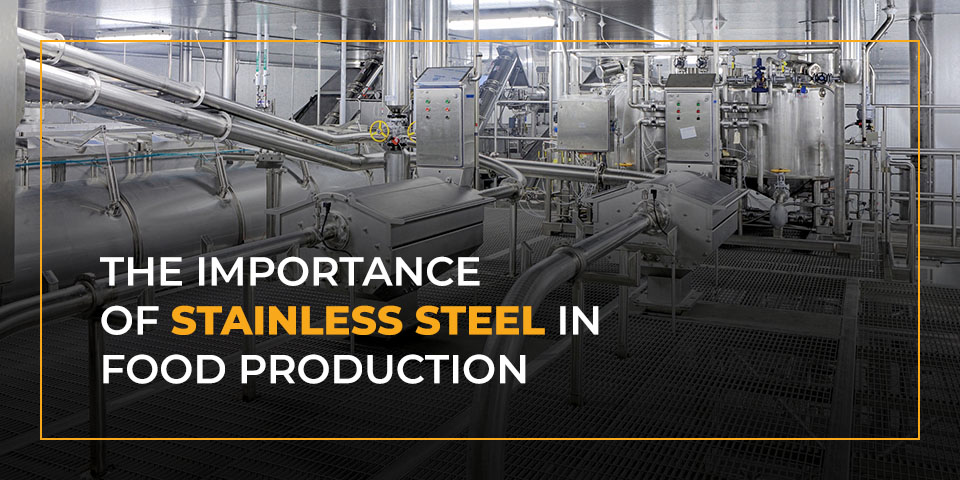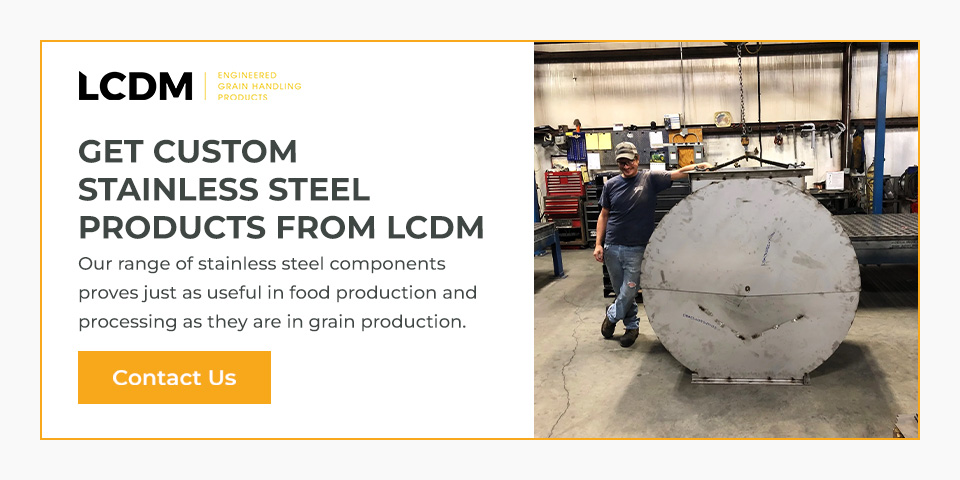Food production companies all over the world are faced with strict standards. International regulations and compliance criteria are getting stricter to ensure food is made, shipped and stored safely. More machinery is required as the process becomes more automated for faster production. This machinery must be constructed with food safety and health regulations in mind. Ensuring these machines comply with strict international food regulations means using the right materials to make them.
There is much more that stainless steel can do in the food industry than you might expect. This analysis of the usefulness of stainless steel in the food industry will explain why it’s so helpful.
The Different Types and Grades of Stainless Steel
There are roughly 150 grades of stainless steel, each with its own distinct properties and benefits. There are also five different types of stainless steel, which are then divided into multiple different grades. The grades vary in temperature resistance, quality and durability. These are the five types of stainless steel and what makes them unique.
Ferritic
Ferritic steels are used for architectural purposes and auto trim. As a result, it is rarely used in kitchens and the food industry. This type of steel has a low carbon content at less than 0.2% carbon. This means it cannot be hardened using heat treatment. It can only be hardened through cold working. The most popular ferritic steel grades are 409, 430, 439 and 441.
Austenitic
Austenitic steel shares many similar properties with ferritic and martensitic steels. The main difference between them is the chemical composition. Austenitic steel is around 35% nickel and between 16 and 26% chromium. The most common grades of this type are 304 and 316. This type of stainless steel is nonmagnetic, ductile and durable. Like ferritic steel, it also cannot be hardened by heat treatment. Austenitic steel has the highest corrosion resistance than any other type of stainless steel.
Its properties make this the most commonly used type of stainless steel in the food-processing industry.
Austenitic-ferritic
As the name suggests, austenitic-ferritic metal is made of equal parts of austenitic and ferritic stainless steel. The combination of both types of metal makes this well-suited for chemical storage and processing.
Martensitic
Martensitic stainless steel contains 10.5 to 18% chromium and 1.2% carbon. This means heat treatments can harden it. Martensitic steel is strong, ductile and magnetic with moderate corrosion resistance. Many of the 400-level grades of stainless steel are martensitic. It is common to find this steel in kitchens as it is used in cutlery. It can also be used in turbines, tools and surgical instruments like scalpels.
Precipitation Hardening
Precipitation hardening stainless steel is mostly used in construction for pumps, shafts and valves. It is known for its strength and corrosion resistance.
Grades of Stainless Steel
There is a big difference between the type of stainless steel and its grade. The types refer to the type of metal that makes up the alloy, while grades describe the properties of the steel. These properties include magnetism, toughness and corrosion resistance. Different types and grades are acceptably hygienic in the food production industry.
The Unique Properties of Stainless Steel
Stainless steel is a valuable metal as it is easy to produce and has several unique properties that make it an essential part of the food industry. These are the main reasons stainless steel is used in many parts of the food industry.
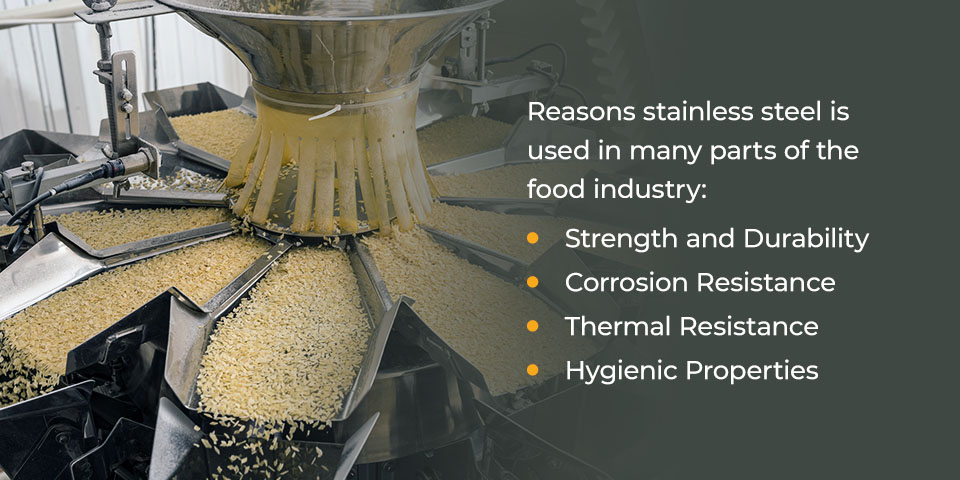
Strength and Durability
Stainless steel can endure the stress of daily wear and tear it will encounter in the food industry. It is an incredibly strong and durable material. It can resist stains, corrosion and rust, making it the best material for the machinery and surfaces involved in food production. It is preferable over wood and plastic in commercial kitchens as they are more vulnerable materials.
Corrosion Resistance
The introduction of chromium in stainless steel gave it enhanced protection against corrosion. When it comes in contact with oxygen, chromium will produce a protective layer. This layer is what makes it more resistant to corrosion and rust. Grade 316 is the best type of steel for food production and commercial kitchens because of its corrosion resistance.
Thermal Resistance
Being as tough as it is, stainless steel is highly heat-resistant. It is also not susceptible to embrittlement in very low and very high temperatures. The amount of chromium used in the grade of stainless steel you use affects its thermal resistance. Stainless steel is better at retaining its strength than aluminum and galvanized steel.
Stainless steel grades of 310 can withstand temperatures up to 2,000 degrees Fahrenheit.
Hygienic Properties
One of the most valuable attributes of stainless steel in the food industry is its hygienic properties. Being non-porous, it will not absorb or retain bacteria, dirt or odors. This makes it incredibly useful for kitchen surfaces and machines that handle food. It is highly sought after for appliances and utensils as well.
The hygienic properties of stainless steel offer another valuable attribute. It is low maintenance and easy to clean. All you need to do to clean it is wipe it down with a damp cloth or wash it with a mild soap and warm water.
The Importance of Stainless Steel in Food Production
Food production is a broad term that covers an array of different industries and means of production. It includes baking, freezing, canning, packaging, mixing, grinding, slicing, cultivation, crop production, harvesting, fermenting and much more. These are the ways that stainless steel is used in this part of the food industry.
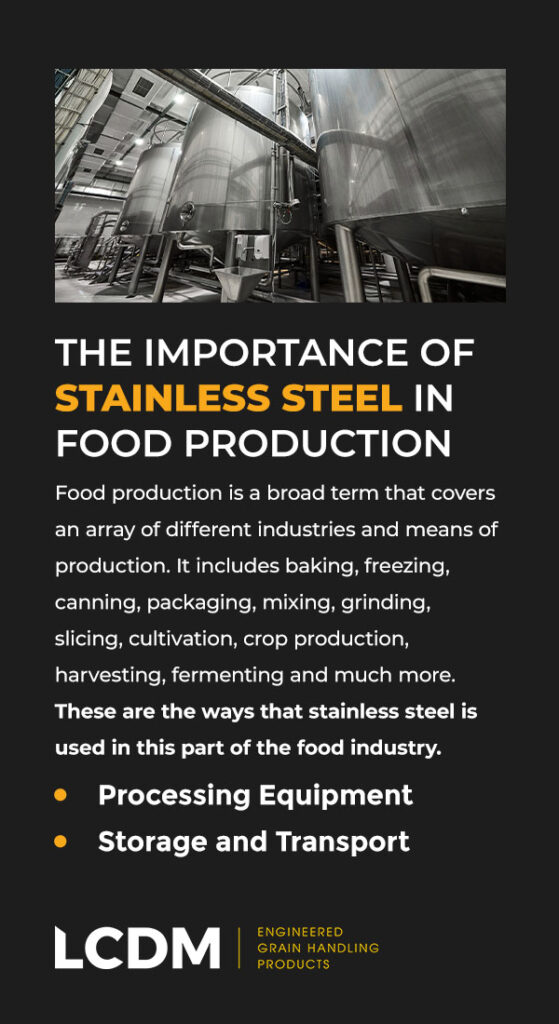
Processing Equipment
Preparation, mechanical processing, heat processing and harvesting equipment are all vital parts of food processing. Preparation equipment is used to clean, sort and prepare food. Stainless steel is well suited for preparation equipment as it is easy to sterilize and its durability makes it last a long time. From spray washers, flotation tanks and ultrasonic cleaners, stainless steel can be used to make reliable parts that will always be clean.
Mechanical processing equipment is used to alter the shape and size of food. Meat grinders, blades, saws, attrition mills and emulsifiers are examples of equipment used during this stage. Stainless steel’s surface structure means it is hard to chip, meaning there is no entry point for dirt and bacteria. This means equipment that handles food directly will always be clean, sharp, and effective.
Heat processing equipment needs to have thermal and corrosion-resistant properties. These are well-known attributes held by stainless steel. Machines that work at incredibly high heat while cooking food will not be affected by the extreme heat they will constantly be working at.
The same applies to preservation equipment, which involves applying chemicals and refrigerating food. The thermal resistance and chemically neutral attributes of stainless steel make it the perfect material for the job.
Storage and Transport
Stainless steel is an ideal material for food storage and transportation. Given its thermal resistance, it can make refrigerated storage facilities that low temperatures will not compromise. It is also a smart choice of material because of its hygienic properties.
The different grades of stainless steel and the finishes that can be applied to it make it an ideal material for making surfaces and storage units in the food production industry. Stainless steels within the 300 and 400 grades range are best for surfaces and fixtures. They are capable of storing beer and dairy products while upholding sanitation regulations. This is because the metal’s smooth surface prevents contamination and bacteria from spreading.
The corrosion-resistant nature of stainless steel means it can store liquids with ease. As a metal, it is not affected or compromised by constant exposure to moisture and liquids.
The Importance of Stainless Steel in Commercial Kitchens
Stainless steel has a wide range of uses in commercial kitchens. From kitchen surfaces to appliances and cutlery, stainless steel is as versatile as it is helpful. These are some of the many ways commercial kitchens use this material in their food preparation and operation.
Easy to Clean and Maintain
Stainless steel surfaces are resistant to corrosion, stains, discoloration and odor. The smooth surface and durability of stainless steel make it hard to chip or dent. This means bacteria and grime have no way of getting stuck in or being retained by the surface.
Discoloration and odors occur when bacteria and dirt remain on the surface. The odors build up as more bacteria multiply and more dirt gets trapped. Discoloration is the effect of bacteria and other harmful materials damaging the integrity of the surface.
By being smooth, durable and corrosion-resistant, stainless steel can avoid all of these issues. This is a major advantage for a commercial kitchen where wear and tear can greatly damage surfaces.
Not only does the smooth surface of stainless steel not retain dirt, but it is also easy to clean. Dirt slides right off and only a damp cloth is required to remove smudges, spills and grime. With no friction to slow down your cloth, it takes a few moments to sterilize and clean the stainless steel countertops in commercial kitchens.
Thermal Resistance
Commercial kitchen surfaces are exposed to extremely hot and cold temperatures. Being near ovens and fridges and having warm dishes or frozen ingredients placed on them at all times can result in a lot of wear and tear. Stainless steel’s thermal resistance makes it the perfect fit for the demanding requirements of a commercial kitchen.
Safety and Hygiene
The non-reactive nature of stainless steel makes it a perfect match for a commercial kitchen. Cleaning chemicals that commercial kitchen countertops are exposed to can do a lot of damage when used frequently. However, stainless steel resists the corrosive effects of these agents while remaining clean.
Using stainless steel also prevents the chances of cross-contamination. Commercial kitchen surfaces risk cross-contamination by being exposed to different ingredients, people and germs. The non-reactive properties of stainless steel eliminate the risk of cross-contamination occurring across everything it makes contact with. Foodborne diseases can be severe, but stainless steel goes a long way towards reducing the risks of them spreading around a commercial kitchen.
The Importance of Stainless Steel in Food Processing
The different attributes of stainless steel change based on their grade. As a result, there are some grades that are perfectly suited for the tasks involved in the food processing industry.
Uses in Food Processing
Three grades of stainless steel are most commonly used in the food industry. Their ability to perform and abide by the strict regulations makes them valuable and sought after. These three grades are:
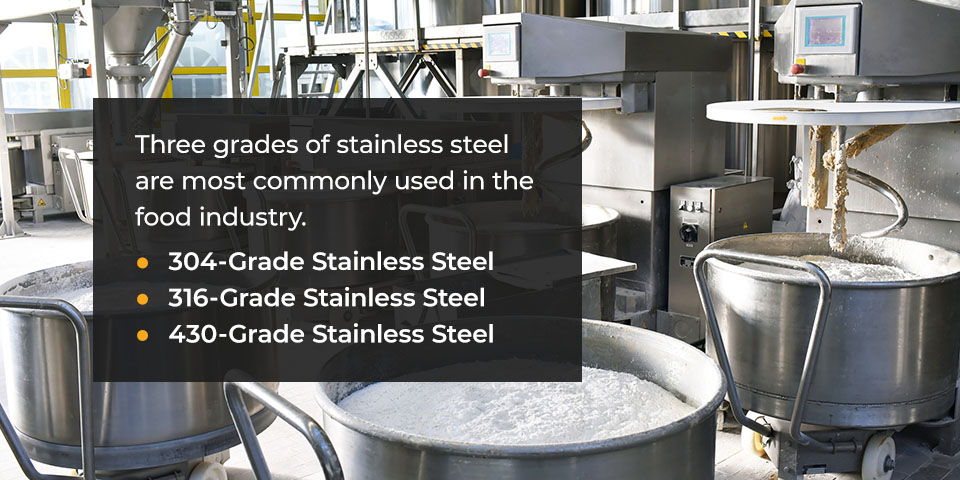
304-grade stainless steel: This affordable option is perfect for any food processing environment. It can be sanitized without corrosion by oxidizing acids in stronger cleaning agents. Its formability allows it to be manufactured into a variety of shapes for different food processing equipment. 304-grade stainless steel is used in dishwashers, storage tanks, fermentation vats and other commonly used equipment.
316-grade stainless steel: This austenitic alloy contains high percentages of chromium and nickel. This combination makes its thermal resistance even tougher. It also resists the corrosive effects of salts, chlorides, acids and alkalis. These qualities make it perfect for food preparation processes like cooking and seasoning.
430-grade stainless steel: Grade 403 steel contains the same levels of chromium that 316 does, but a fraction of the nickel. 403’s biggest strength is its resistance to nitric and organic acids. This makes it useful for applications that involve extended contact with acidic compounds.
Versatility and Customization
The shape and size of stainless steel can be manipulated and molded in manufacturing to make it useful in endless ways in the food processing industry. Stainless steel is actually replacing other metallic materials used in the industry because of how suitable it is. It can be used in cutlery, tableware, transport, storage, kitchen surfaces, ovens, refrigerators and other essential appliances.
The flexibility and product diversification it offers in the food industry is astounding. The three main grades are the most popular, but several others can still be found in every part of the industry. From optimizing processes to creating reliable and safety-compliant products, there is no doubt that stainless steel deserves its reputation in the food industry.
Get Custom Stainless Steel Products From LCDM
LCDM specializes in providing high-quality grain processing equipment, but that’s not all it can be used for. Our products are just as useful for food production companies as well. There is a surprising amount of overlap between what grain production products can do for food production. Our range of stainless steel components proves just as useful in food production and processing as they are in grain production.
For over four decades, we have been providing products that optimize processes. Through the years, our designs and engineering have evolved into the distinctive and helpful products we have today. Contact us to find out more about what our products and our offerings can do for you.

